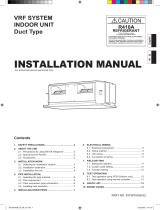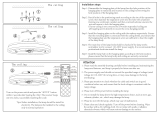
En-2
1. SAFETY PRECAUTIONS
• Be sure to read this Manual thoroughly before installation.
• The warnings and precautions indicated in this Manual contain important information per-
taining to your safety. Be sure to observe them.
• Hand this Manual, together with the Operating Manual, to the customer. Request the
customer to keep them on hand for future use, such as for relocating or repairing the unit.
WARNING
This mark indicates procedures which, if improperly per-
formed, might lead to the death or serious injury of the user.
Request your dealer or a professional installer to install the indoor unit in accordance
with this Installation Manual. An improperly installed unit can cause serious accidents
such as water leakage, electric shock, or fi re. If the indoor unit is installed in disregard of
the instructions in the Installation Manual, it will void the manufacturer’s warranty.
Do not turn ON the power until all work has been completed. Turning ON the power
before the work is completed can cause serious accidents such as electric shock or fi re.
If refrigerant leaks while work is being carried out, ventilate the area. If the refrigerant
comes in contact with a fl ame, it produces a toxic gas.
Installation work must be performed in accordance with national wiring standards by
authorized personnel only.
CAUTION
This mark indicates procedures which, if improperly per-
formed, might possibly result in personal harm to the user, or
damage to property.
Read carefully all security information before use or install the air conditioner.
Do not attempt to install the air conditioner or a part of the air conditioner by yourself.
This unit must be installed by qualifi ed personnel with a capacity certifi cate for handling
refrigerant fl uids. Refer to regulation and laws in use on installation place.
The installation must be carried out in compliance with regulations in force in the place
of installation and the installation instructions of the manufacturer.
This unit is part of a set constituting an air conditioner. It must not be installed alone or
with non-authorized by the manufacturer.
Always use a separate power supply line protected by a circuit breaker operating on all
wires with a distance between contact of 3mm for this unit.
The unit must be correctly earthed (grounded) and the supply line must be equipped
with a differential breaker in order to protect the persons.
The units are not explosion proof and therefore should not be installed in explosive
atmosphere.
Never touch electrical components immediately after the power supply has been turned
off. Electric shock may occur. After turning off the power, always wait 5 minutes before
touching electrical components.
This unit contains no user-serviceable parts. Always consult authorized service person-
nel to repairs.
When moving, consult authorized service personnel for disconnection and installation
of the unit.
This appliance is not intended for use by persons (including children) with reduced
physical, sensory or mental capabilities, or lack of experience and knowledge, unless
they have been given supervision or instruction concerning use of the appliance by a
person responsible for their safety. Children should be supervised to ensure that they do
not play with the appliance.
2. ABOUT THIS PRODUCT
2.1. Precautions for using R410A refrigerant
WARNING
Do not introduce any substance other than the prescribed refrigerant into the refrigera-
tion cycle. If air enters the refrigeration cycle, the pressure in the refrigeration cycle will
become abnormally high and cause the piping to rupture.
If there is a refrigerant leak, make sure that it does not exceed the concentration limit.
If a refrigerant leak exceeds the concentration limit, it can lead to accidents such as
oxygen starvation.
Do not touch refrigerant that has leaked from the refrigerant pipe connections or other
area. Touching the refrigerant directly can cause frostbite.
If a refrigerant leak occurs during operation, immediately vacate the premises and thor-
oughly ventilate the area. If the refrigerant comes in contact with a fl ame, it produces a
toxic gas.
2.2. Special tool for R410A
WARNING
To install a unit that uses R410A refrigerant, use dedicated tools and piping materi-
als that have been manufactured specifi cally for R410A use. Because the pressure of
R410A refrigerant is approximately 1.6 times higher than the R22, failure to use dedi-
cated piping material or improper installation can cause rupture or injury. Furthermore, it
can cause serious accidents such as water leakage, electric shock, or fi re.
Tool name Changes
Gauge manifold
The pressure in the refrigerant system is extremely
high and cannot be measured with a conventional
gauge. To prevent erroneous mixing of other refriger-
ants, the diameter of each port has been changed. It
is recommended to use a gauge manifold with a high
pressure display range of –0.1 to 5.3 MPa and a low
pressure display range of –0.1 to 3.8 MPa.
Charging hose
To increase pressure resistance, the hose material
and base size were changed.
(The charging port thread diameter for R410A is 1/2
UNF 20 threads per inch.)
Vacuum pump
A conventional vacuum pump can be used by install-
ing a vacuum pump adapter.
Be sure that the pump oil does not back fl ow into
the system. Use one capable for vacuum suction of
–100.7 kPa (5 Torr, –755 mmHg).
Gas leakage detector Special gas leakage detector for R410A refrigerant.
2.3. Accessories
WARNING
For installation purposes, be sure to use the parts supplied by the manufacturer or other
prescribed parts.
The use of non-prescribed parts can cause serious accidents such as the unit to fall,
water leakage, electric shock, or fi re.
• The following installation parts are furnished. Use them as required.
• Keep the Installation Manual in a safe place and do not discard any other accessories
until the installation work has been completed.
INSTALLATION MANUAL
PART No. 9378590069-03
INDOOR UNIT (Cassette type)
Contents
1. SAFETY PRECAUTIONS .........................................................................................2
2. ABOUT THIS PRODUCT ..........................................................................................2
2.1. Precautions for using R410A refrigerant ...........................................................2
2.2. Special tool for R410A ...................................................................................... 2
2.3. Accessories .......................................................................................................2
2.4. Optional parts....................................................................................................3
3. INSTALLATION WORK .............................................................................................3
3.1. Selecting an installation location ....................................................................... 3
3.2. Installation dimension ....................................................................................... 3
3.3. Installation the unit ............................................................................................4
4. PIPE INSTALLATION ................................................................................................5
4.1. Selecting the pipe material................................................................................5
4.2. Pipe requirement...............................................................................................5
4.3. Flare connection (pipe connection) ................................................................... 5
4.4. Installing heat insulation....................................................................................6
5. INSTALLING DRAIN PIPES .....................................................................................6
6. ELECTRICAL WIRING ..............................................................................................7
6.1. Wiring system diagram ..................................................................................... 7
6.2. Connection cable preparation ...........................................................................8
6.3. Connection of wiring ......................................................................................... 8
7. REMOTE CONTROLLER SETTING ........................................................................8
7.1. Installing the remote controller .......................................................................... 8
7.2. Setting the dip switches ....................................................................................9
8. CASSETTE GRILLE INSTALLATION .......................................................................9
9. FUNCTION SETTING ............................................................................................... 9
9.1. Turning on the power ........................................................................................ 9
9.2. Function setting...............................................................................................10
10. SPECIAL INSTALLATION METHODS ....................................................................12
11. TEST RUN ..............................................................................................................12
12. CHECK LIST ...........................................................................................................13
13. OPTIONAL KIT INSTALLATION (OPTION) ............................................................ 13
14. CUSTOMER GUIDANCE ....................................................................................... 13
15. ERROR CODES .....................................................................................................13















